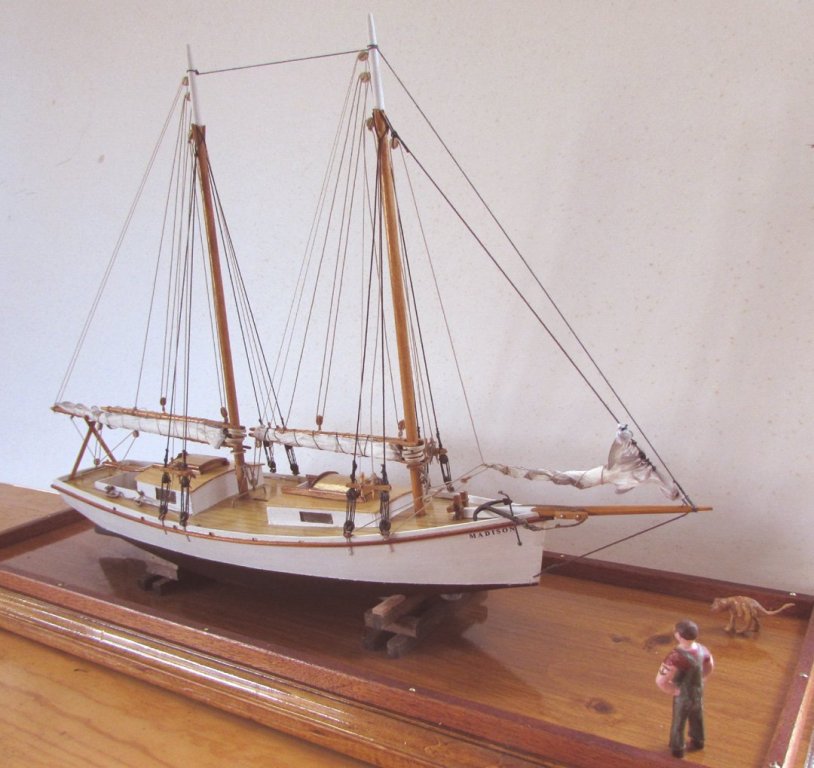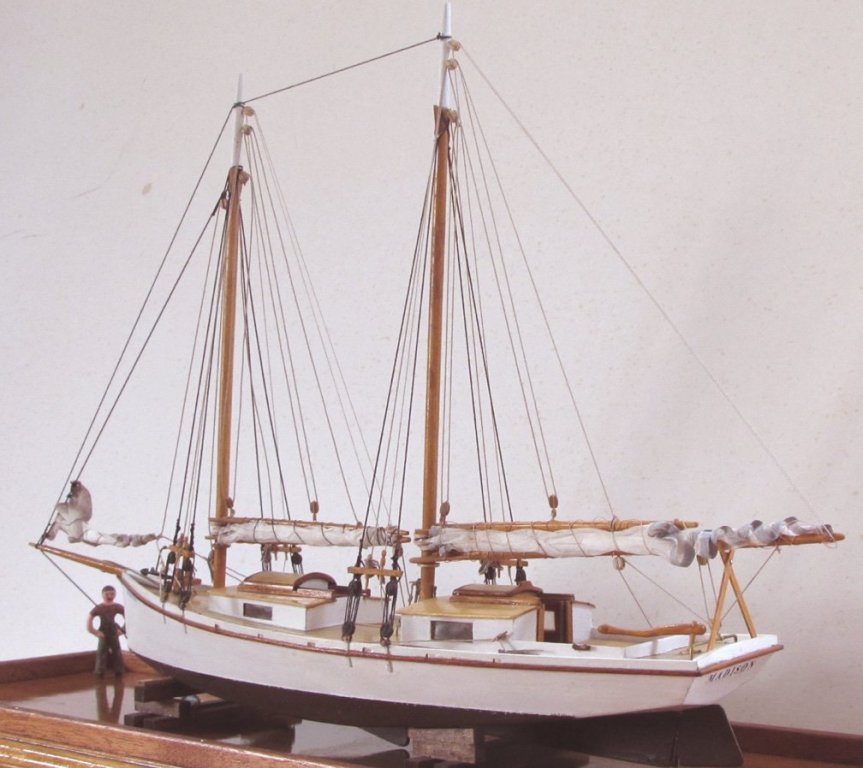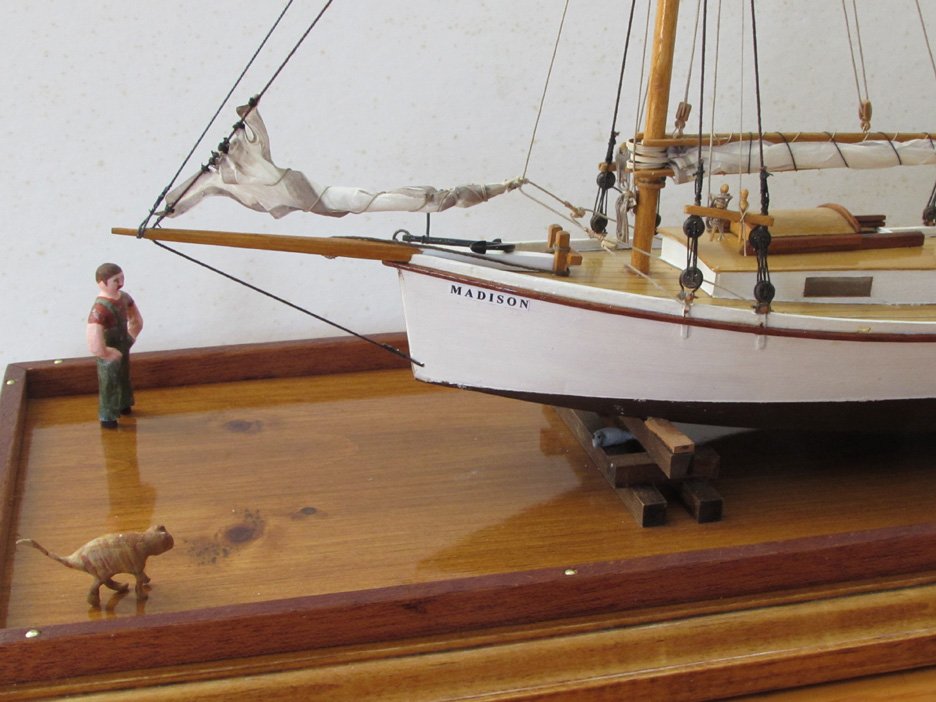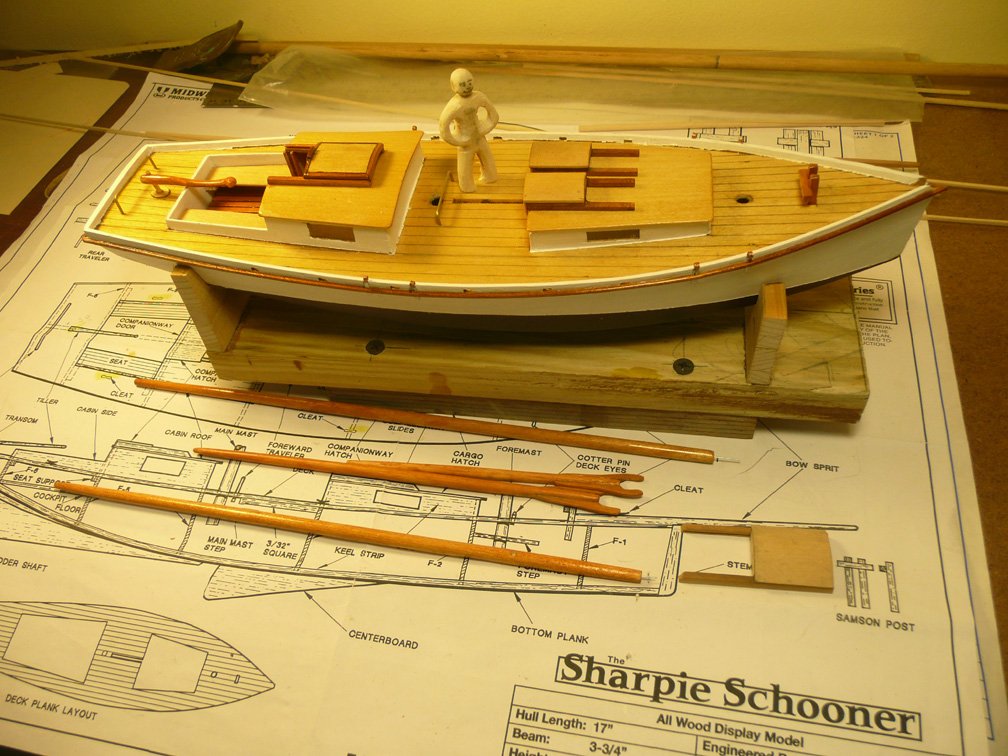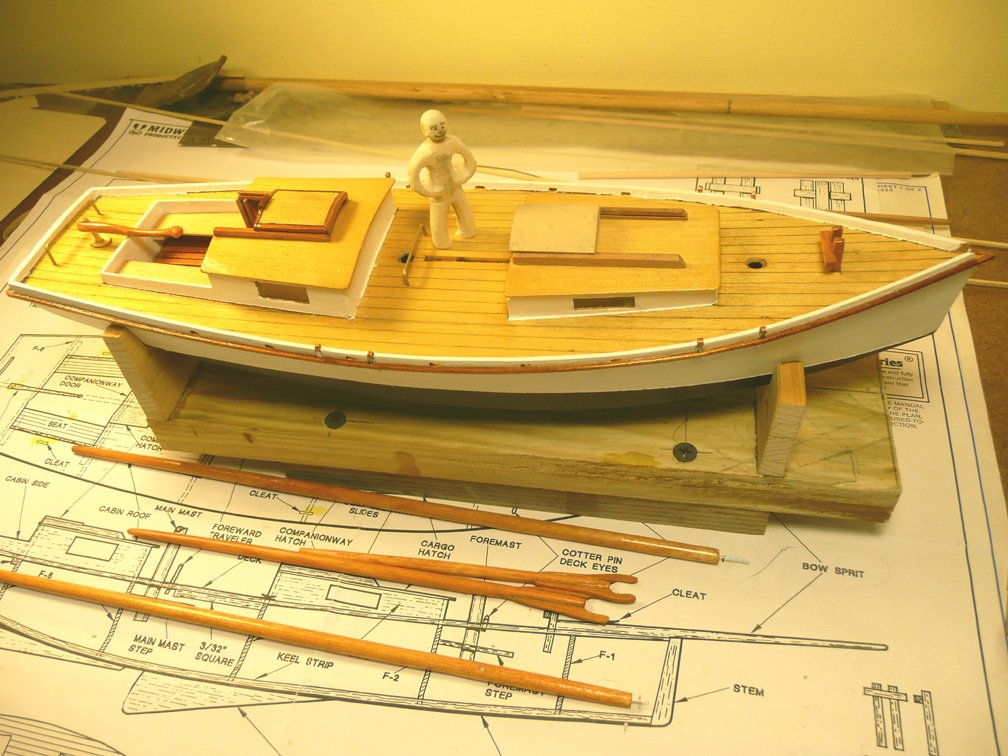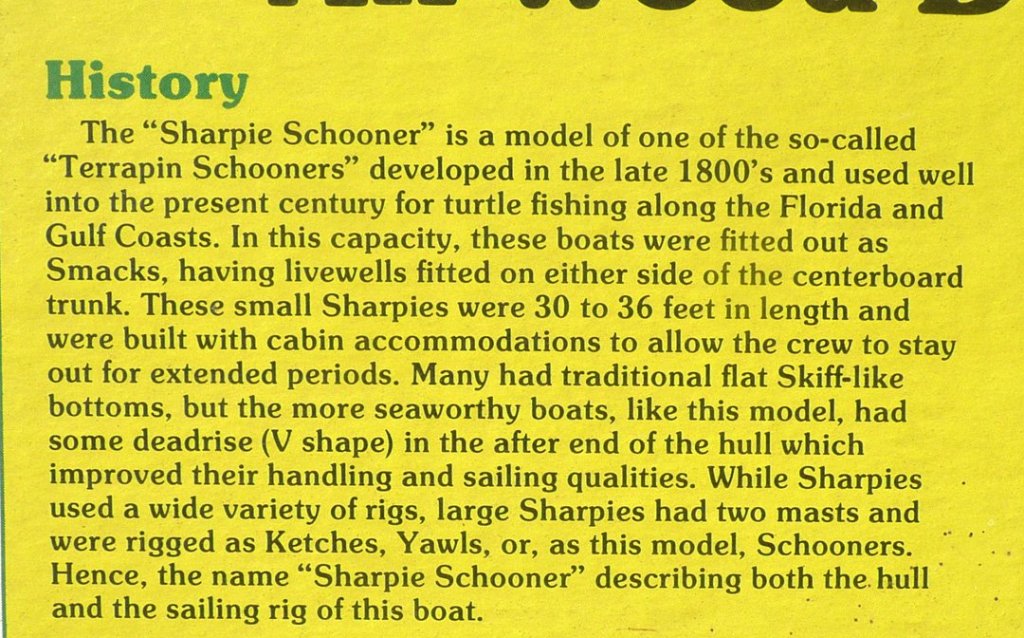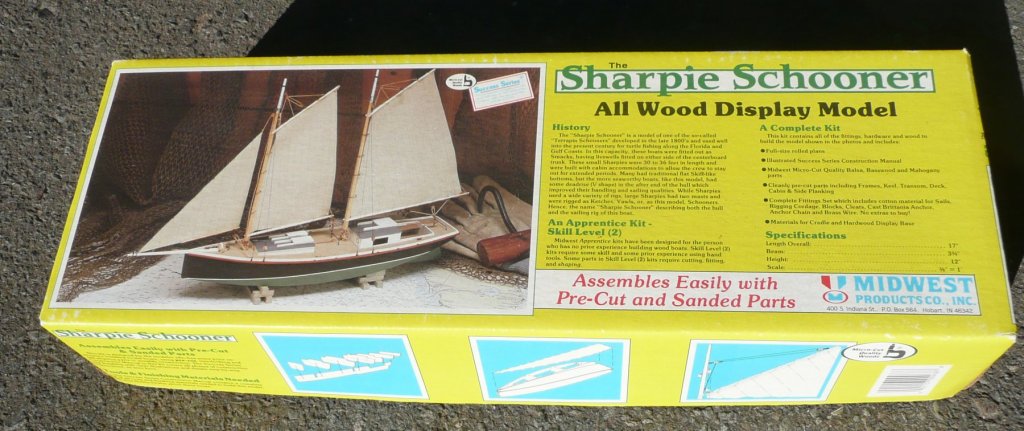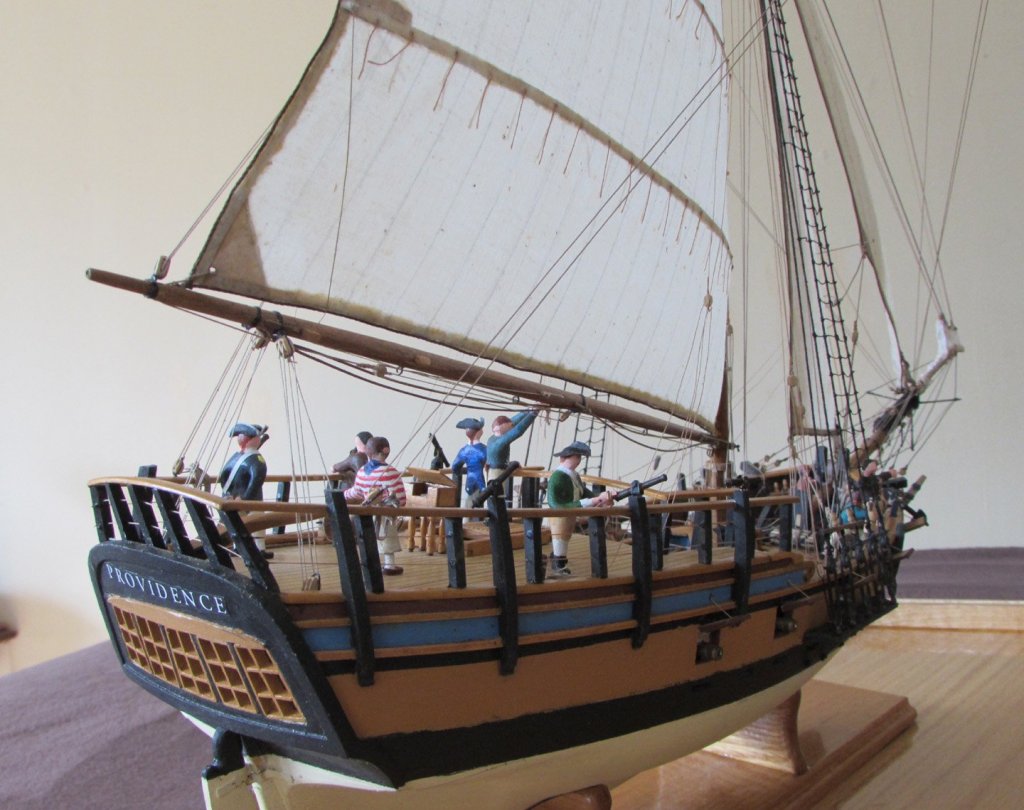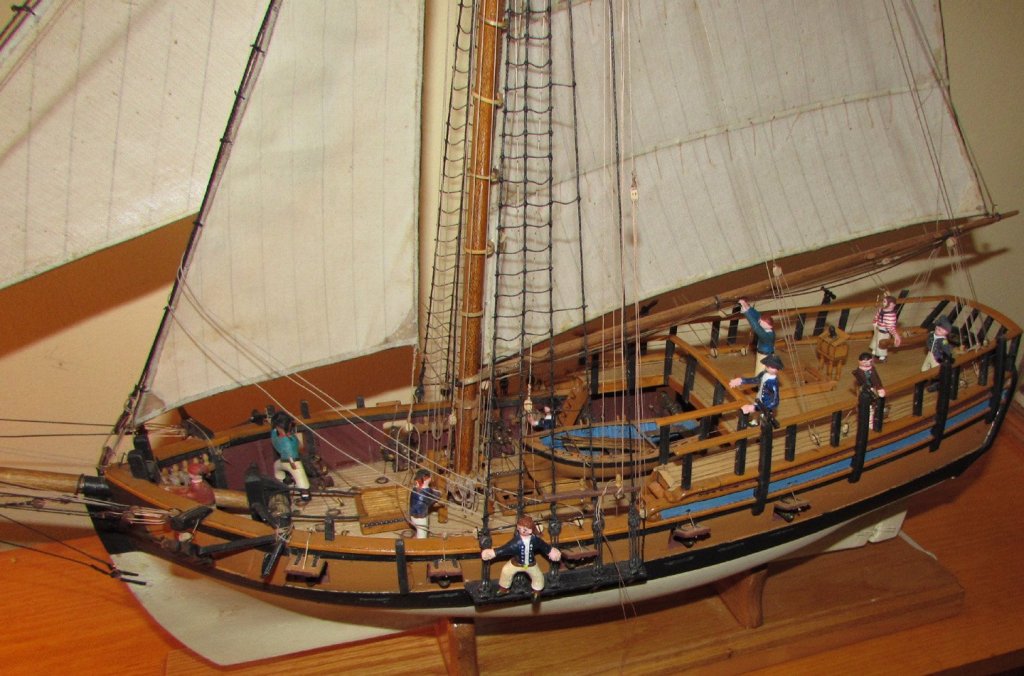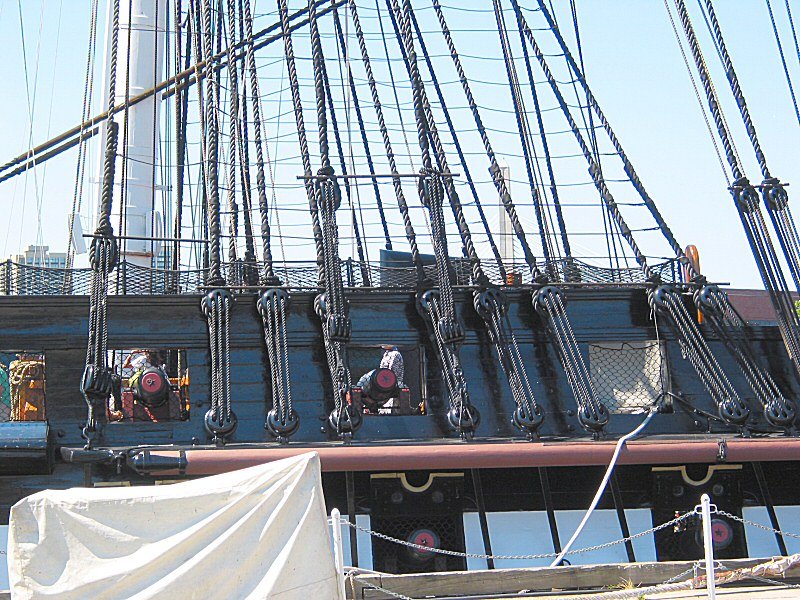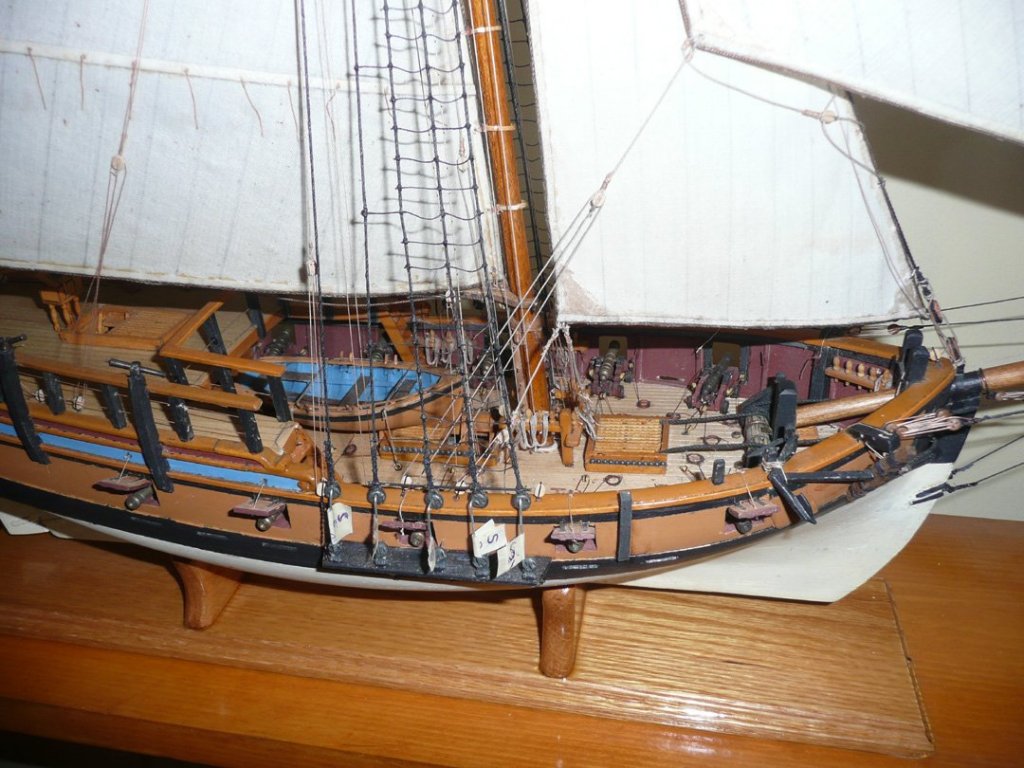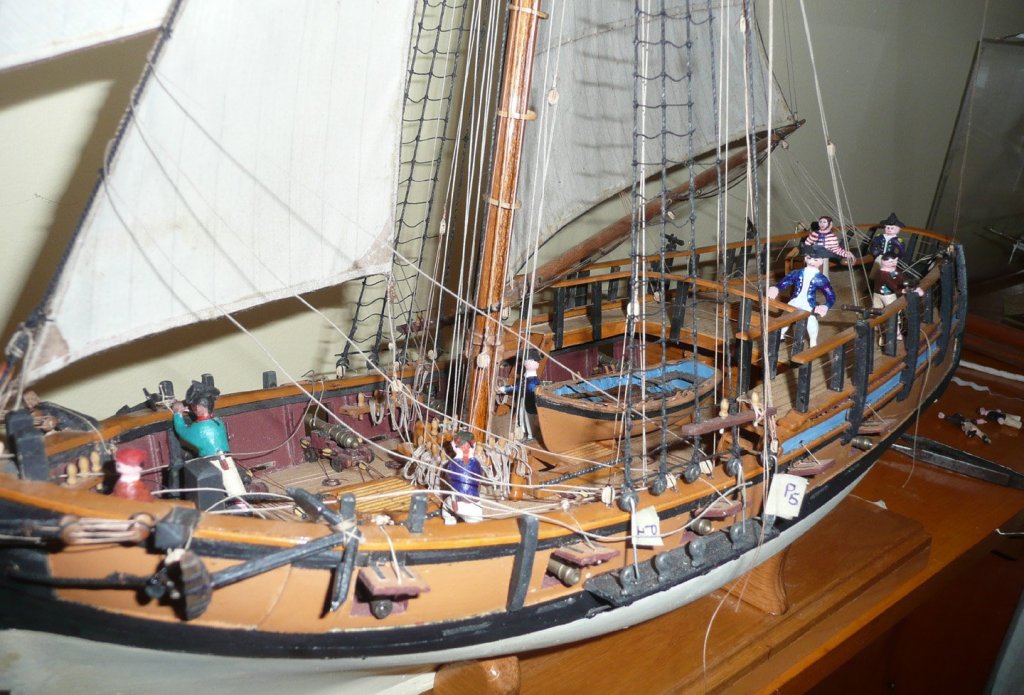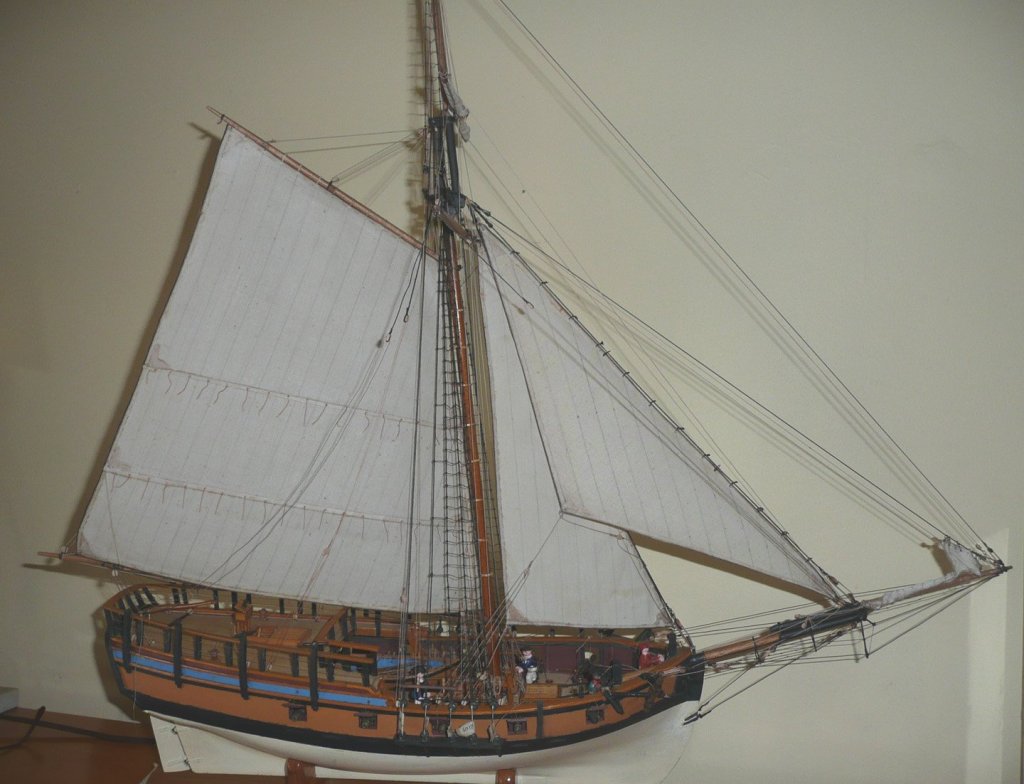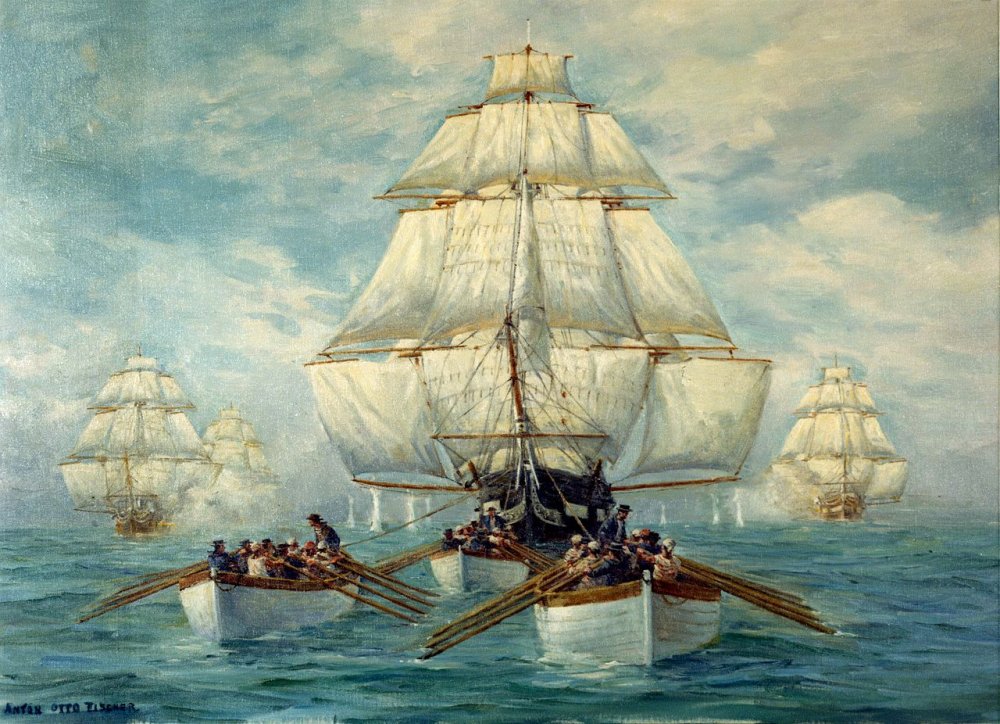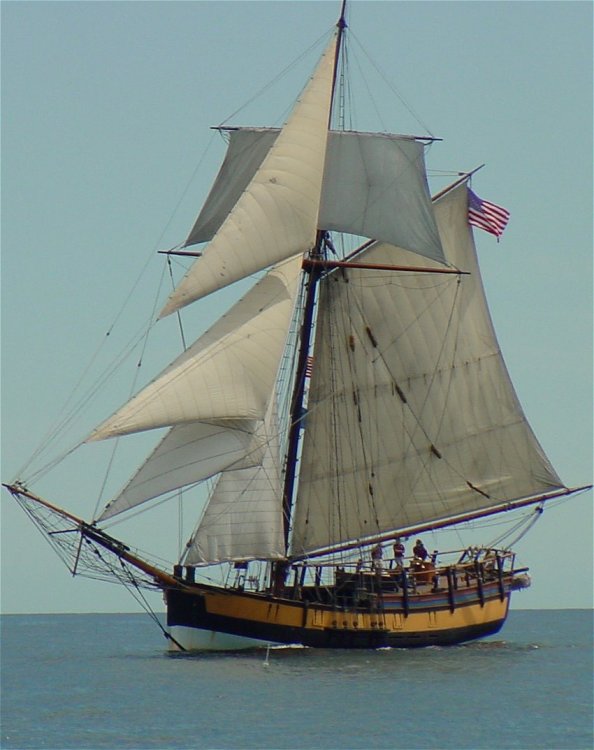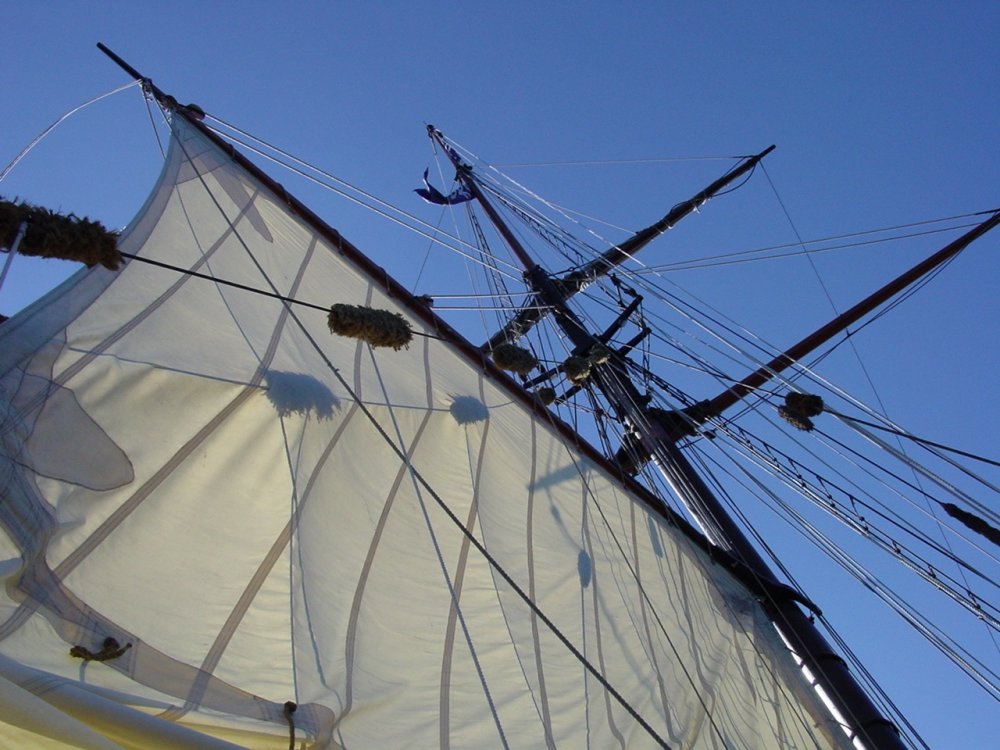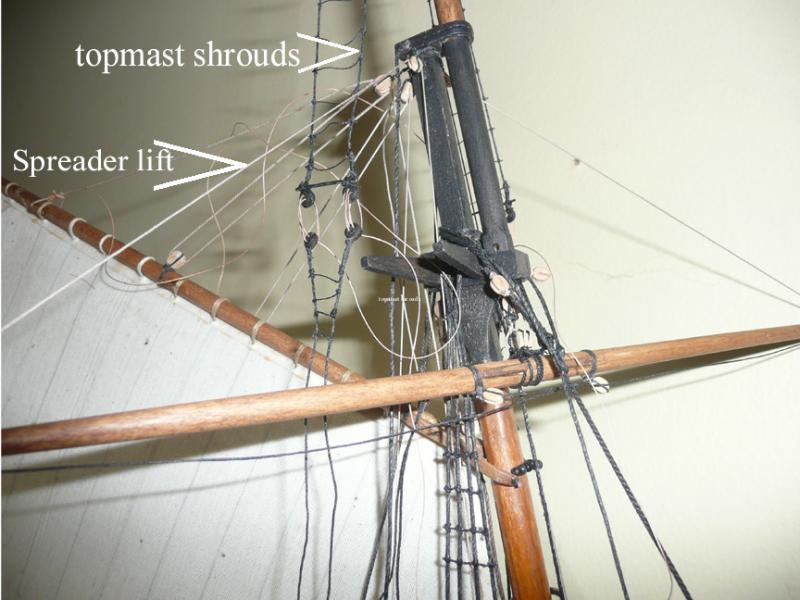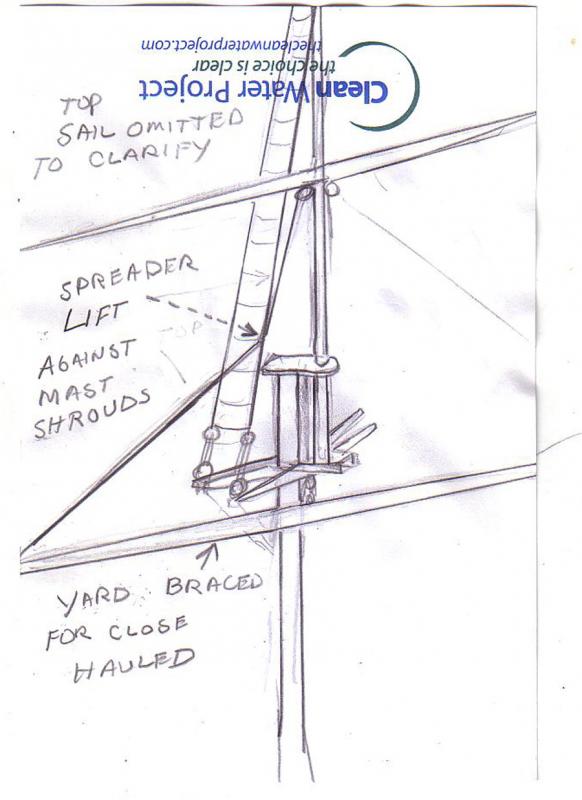-
Posts
393 -
Joined
-
Last visited
Content Type
Profiles
Forums
Gallery
Events
Everything posted by Senior ole salt
-
OK it's finished a bit different than the plans. Now she is a yacht waiting to be launched as her skipper look on as the ships cat is on the hunt.
- 5 replies
-
- sharpie schooner
- Midwest Products
-
(and 1 more)
Tagged with:
-
The instruction booklet was very good but the plans lack any detail of the hatches etc. According to the plan the 2 fwd cargo hatches each have less then a foot clearance to load and unload turtle cargo. A crewman would have to go below and carry out the turtles. Unless this person is extremely thin I cannot see how this is accomplished. So I just might install a one larger hatch system enabling a useable hatch for the persons of that period. In the image is a 5'3" tall crew. I realize the centerboard trunk/case divides this space but the case can be cut down some allowing more room to attend to the turtle cargo. After all the skipper/ owners would fit out his vessel to suit him self giving me liberty to do the same. SOS
- 5 replies
-
- sharpie schooner
- Midwest Products
-
(and 1 more)
Tagged with:
-
First a little about this craft This is a working schooner but my interpretation is a vessel coming fresh from a refit and things looking a bit new and not showing the "toil" of the fishermen. SOS
- 5 replies
-
- sharpie schooner
- Midwest Products
-
(and 1 more)
Tagged with:
-
Way back in 2014 I picked up this kit at the local flea market for a few bucks. The contents were all warped and the plans missing, gone in some flood. So I said to myself why not try to put it together all the parts seemed to be there and pre cut , what can go wrong ? The sides the bulkheads the bottom the cabin etc all pre cut and obvious where which part mates to which part. So I put it together and it went OK just a few parts left over. I mentioned this on back in Oct 2014 here on the Forum about no sail plan and later got a package in the mail from J. F. from LA USA ( thanks again J. F) with the instruction booklet, complete plans and with the sail and rigging diagrams. I contacted Chuck to get the users name of the person who kindly sent me all I need to build the model, but no luck with that. Then along came the request to build the Sloop Providence Completed and posted on the "Scratch built Forum" for my son in law so this little schooner model had to be shelved for for a while. Presently I am working on the model and posting a bit late with the progress but BETTER LATE THEN NEVER SHARPIE. SOS
- 5 replies
-
- sharpie schooner
- Midwest Products
-
(and 1 more)
Tagged with:
-
Lou congratulations on starting your Providence build log I put one US enlisted Marine aboard. He's preparing the swivel gun to fire off a salute. There are more pix of my build in the scratch completed section. If you look close there is one dog aboard . Part of the prize crew the Providence took on one cruise. Here is one image with the US Marine, in the green uniform of that period. SOS
-
Getting close to the finish line here . The dead eyes ( using black or tared lanyards) have been reeved and a few crew members have reported aboard. Will make a Marine ( will be loading a saluting cannon and wearing a green uniform ) as this vessel has the distinction of having the first amphibious landing of the USMC. from this vessel. I'm still puzzled about what flag to hoist The" Grand union", "Don't tread on me" or the 13 star and 13 stripes flag. Any suggestions ? My intention is that this vessel will have a theme which is when finished. SOS Colonial Sloop Providence diorama display explanation The sloop Providence is close hauled tacking into NW force 4 wind as she looks for a safe anchorage in friendly waters , hopefully close to an established town for re-provisioning On deck are 12 crew members. Starting at the bow stb. side is the ships Bo'sun. He is loosening the lashing on the anchors fluke. It will be eased off to hang from the cat head to be released at the word of the Captain.. Across from him on the port side a seaman is preparing to pull on the jib down haul.. At the mast another sailor approaching the jib halyard to let it go to lower the sail , both will eventually furl the sail just leaving the fore stay sail drawing which may be used in "backing " to help sail the sloop backwards as she lay's out her cable when anchoring. On deck stb. side is the midshipman to supervise the anchoring evolution. He thinks he is important but the ships Bo'sun is far more experienced Above him on the ships rail is another sailor pointing to obstructions that lie ahead. He just came from aloft where he furled the top sail Opposite him secured to the shrouds is the leads man. He is taking soundings to determine the depth. He looks a little worried as the lead line showed 4' beneath the keel. On the quarter deck port side a seaman belays the running back stay as the sloop just completed a tack. Another sailor is preparing to "dip the colors" as a US Marine is preparing the saluting swivel gun on the stb. side The first lieutenant overlooks it all as the most experienced quartermaster mans the tiller. The Captain is all the way aft and knows the ship is in good hands and is probably calculating his share of prize money after a successful cruise off shore sinking and capturing British merchant, war ships and raiding shore facilities.
-
Chuck, that puzzled me too as a upright post interferes with the function of the gun. My solution was to beef up the ladder sides anchoring them in the main deck on the bottom and to receive a fore and aft beam on the quarter deck on top, figuring it only had to support the weight of one person on the ladder at one time. Perhaps not orthodox method but for me with primitive plans to work from, it works. Please don't tell any one how I fudged it What might be better would lay out the gun ports more carefully or the quarter deck end in relation to the ladder and gun function Hope this helps you SOS.
-
Getting close to finishing this scratch model. I need to rig the dead eye lanyards but need to know what color black or natural. The plans for the Virginia sloop call for black lanyards. But i see many models here rigged natural. Just how often were these lanyards taken up back in 1776. I think they would be lightly tarred there fore leaning darker than natural. I did make a few crew for the model some in place but one in the "chains" or on the channell needs the deadeye rigged. So my question here is What color black, natural or lightly tarred ? Thanks SOS
-
Outstanding work.a bit of history preserved as well . Thanks for posting SOS
-
Is there an solvent for this paint? Although the cover was screw down tight, it seems to be all dried out and completely unusable now. The writing on the bottle is all blurred and not readable. What to do ? Maybe the acrylic stuff in tubes is better. I still have some used for painting that deals with TIME better than Model Expo Paint Thanks SOS
-
Yes they are treated to conform to a shape suggestive of wind in the sail Well after letting this model sit o the shelf for a while I got back into the groove again and picked up on it again thanks to a member here with a loan of plans of the Virginia sloop as a guide. I also put in some of my own take on just where sheets should be belayed to. I want to present a 'theme" for the display, that is for this model close hauled on the port tack with the topsail furled as well as the outer jib. I'l like to put a sailor in the "chains" taking soundings as well as a few crew scattered around preparing the vessel to anchor. I have two questions 1. On which side should the sailor taking soundings be , windward or leeward sides ?. I'm thinking windward side as the lead line has the least opportunity of hitting some rigging. The other question is: Considering this model case will be 31" long by 28" High and 14" wide and destined for a household with two cats and a toddler. I'm thinking 3/16" plexiglass might be more durable than 1/8" Any opinions expressed here would be appreciated Thanks SOS PS will take some pix soon.
-
Union Admiral David Dixon Porter leads 12 ships past the heavy barrage of Confederate artillery at Vicksburg, Mississippi. He lost only one ship, and the operation speeded General Ulysses S. Grant’s movement against Vicksburg. Grant had been trying to capture Vicksburg for six months. A first attempt failed when General William T. Sherman’s troops were unsuccessful in attacking Vicksburg from the north. Grant now planned to move his army down the opposite bank of the river, cross back to Mississippi, and approach the city from the east. The soggy spring conditions slowed his advance to a crawl as his force had to build bridges over the bayous on the Louisiana side of the river. To speed the operation, Grant called on Porter to take the ships loaded with men and supplies and run past the powerful Vicksburg batteries. The flotilla quietly moved down the river on the dark night of April 16. The exhausts on the steamboats were vented into the paddle wheel housing to muffle the noise. The boats were positioned off center so that if a ship were hit, the following craft could pass safely. The ships were stacked with cotton bales to act as a soft armor in the event of a direct hit. Confederate pickets spotted the flotilla and sent word to the batteries, and the bombardment began. The commanding Confederate, General John Pemberton, was attending a ball and was quickly summoned to the scene. Some Rebel soldiers even rowed across the Mississippi River to set fire to the trees on the western bank and provide backlighting for their gunners on the eastern shore. It took over two hours for the ships and attached barges to pass. The Union lost only one ship and two barges, and Grant’s plan proceeded. Within six weeks, he had locked up Vicksburg from the east and the siege began. Vicksburg would surrender on July 4, 1863.
-
ometimes in life, the guy with the so-crazy-it-just-might-work ideas hits one out of the park and saves the day. This is what happened in 1942 aboard the HNLMS Abraham Crijnssen, the last Dutch warship standing after the Battle of the Java Sea. Originally planning to escape to Australia with three other warships, the then-stranded minesweeper had to make the voyage alone and unprotected. The slow-moving vessel could only get up to about 15 knots and had very few guns, boasting only a single 3-inch gun and two Oerlikon 20 mm canons making it a sitting duck for the Japanese bombers that circled above. Knowing their only chance of survival was to make it to the Allies Down Under, the Crijnssen's 45 crew members frantically brainstormed ways to make the retreat undetected. The winning idea? Turn the ship into an island. You can almost hear crazy-idea guy anticipating his shipmates' reluctance: Now guys, just hear me out. But lucky for him, the Abraham Crijnessen was strapped for time, resources and alternative means of escape, automatically making the island idea the best idea. Now it was time to put the plan into action. The crew went ashore to nearby islands and cut down as many trees as they could lug back onto the deck. Then the timber was arranged to look like a jungle canopy, covering as much square footage as possible. Any leftover parts of the ship were painted to look like rocks and cliff faces these guys weren't messing around. Now, a camouflaged ship in deep trouble is better than a completely exposed ship. But there was still the problem of the Japanese noticing a mysterious moving island and wondering what would happen if they shot at it. Because of this, the crew figured the best means of convincing the Axis powers that they were an island was to truly be an island: by not moving at all during daylight hours. While the sun was up they would anchor the ship near other islands, then cover as much ocean as they could once night fell praying the Japanese wouldn't notice a disappearing and reappearing island amongst the nearly 18,000 existing islands in Indonesia. And, as luck would have it, they didn't. The Crijnssen managed to go undetected by Japanese planes and avoid the destroyer that sank the other Dutch warships, surviving the eight-day journey to Australia and reuniting with Allied forces. Sometimes in life, the guy with the so-crazy-it-just-might-work ideas hits one out of the park and saves the day. This is what happened in 1942 aboard the HNLMS Abraham Crijnssen, the last Dutch warship standing after the Battle of the Java Sea
-

? for experienced riggers
Senior ole salt replied to Senior ole salt's topic in Masting, rigging and sails
Thanks for all the reply's and suggestions. I'm beginning to think the best solution is to try to suggest a story to the model beholder. The guns are run out. The topsail has been lowered and furled, hands are at the head sail halyards and down hauls. They look to be preparing to lower sails. A sailor in the chains swings the lead. One anchor is "catted", Is it ready to drop? A sailor on a fwd bulwark points at something ahead. Another sailor aft is about to raise a flag but its design is concealed An officer directs the helmsman. Something is about to happen. Each observer of the model could have a different opinion as to what is happening or about to happen. All of the above could make for a more interesting model display. SOS -

? for experienced riggers
Senior ole salt replied to Senior ole salt's topic in Masting, rigging and sails
Roger, not all situations mean speed, capturing a prize or just evading an enemy means cracking on more sail . Just getting some "movement" can make a big difference. SOS -

? for experienced riggers
Senior ole salt replied to Senior ole salt's topic in Masting, rigging and sails
Roger, I know what you are saying about windward work for normal circumstances but picture the scenario as outlined above. A captain hot on the stern of a prize or sailing to escape capture or a battle with a superior enemy and the only course open is to windward. Setting a top sail just might just give the edge. especially if bowlines are rigged. Gregory, This model is for a former skipper (step son) of the replica Sloop Providence He furnished hull plans of poor quality and no rigging plans, just a basic sail plan.( see this build log) A fellow MSW member loaned me the plans for the Armed Virginia sloop , a rig very similar to the Sloop Providence and about the same period. This I used as a general guide to just where things went. I also referred to images of the sloop under full sail in a light wind All of the above had to be tempered with the fact the ex skipper wanted it to look more like a 1776 vessel as apposed to a replica built in the 1970's. I told the ex skipper about my model problem concerning the lift hitting the topmast shrouds when braced for windward work and he said it was never a problem. I think his answer leads me to believe that the replica had schedules and be in a particular place at a certain time and windward work in any air was a problem solved by starting up the auxiliary engine. This still gives me the dilemma as to how to rig the vessel as I envisioned above. In one image(aloft view ) shown here the topsail is lowered. I'm beginning to think as Roger hinted Just square the yards, lower and furl the topsail and just show the fore n aft sails on the model. Unless someone can come up with a full sail on the wind solution. Chuck Beautiful workmanship on your model. Jersey City Frankie Thanks for chiming in on this. Your posted images indicate there are other similar rigged vessels out there but are unclear about the relationship of the lift and topmast shrouds when braced for windward sailing with all sails set. BTW my model will have a few crew aboard. One will be a sailor in the "chains" casting the lead line. Since the model will be healed some, ( wind in those sails ) just where would the leads man be on the windward side or the leeward side ? Thanks all SOS -

? for experienced riggers
Senior ole salt replied to Senior ole salt's topic in Masting, rigging and sails
Mark, thanks for your suggestion but I think loosening the topmast shrouds would mean undoing the dead eye lanyards. This would endanger the support bracing of the topmast. I have never seen baggy wrinkle on any shrouds, but I guess there is a first time. SOS -

? for experienced riggers
Senior ole salt replied to Senior ole salt's topic in Masting, rigging and sails
Thanks Mr. Frankie. I think I'm going to try and think like a skipper at that time (during the American revolution.) My vessel ( single masted sloop of war ) is being pursed by a superior enemy or giving chase to a worthy prize My ample crew are seasoned mariners and know their job and risks. The spreader lift chafing on the topmast shroud is dis concerning which will part first ( probably the lift) especially as there is a sea running, the ship is rolling and pitching causing the two to grind against each other in an alarming manner. The ship expects to be on this tack for some time. The skipper thinks : Should I send men aloft out on the spreader yard and cut the splice that fastened the lift to the yard and simply pass it around the topmast stay lead it clear back to the yard and fasten it with a sized bowline Or rig a temporary lift to support the spreader yard and ease off completely on the regular lift give it plenty of slack and let the jury rig lift support the spreader yard? Which or what would you do ? Thanks SOS -
I'm rigging up the top mast and it's rigging for my scratch built Sloop Providence. It seems that when the sloop is sailing hard on the wind close hauled the spreader yard is hard back as well as the topsail yard. On the model this positions the spreader lift. hard against the topmast shrouds on the leeward side. Windward side no problem unless the vessel is tacked. This cannot be. The question is how is this problem overcome ? Attached are two images,[one a sketch ( excuse the crudeness) and another photo image. Thanks SOS
About us
Modelshipworld - Advancing Ship Modeling through Research
SSL Secured
Your security is important for us so this Website is SSL-Secured
NRG Mailing Address
Nautical Research Guild
237 South Lincoln Street
Westmont IL, 60559-1917
Model Ship World ® and the MSW logo are Registered Trademarks, and belong to the Nautical Research Guild (United States Patent and Trademark Office: No. 6,929,264 & No. 6,929,274, registered Dec. 20, 2022)
Helpful Links
About the NRG
If you enjoy building ship models that are historically accurate as well as beautiful, then The Nautical Research Guild (NRG) is just right for you.
The Guild is a non-profit educational organization whose mission is to “Advance Ship Modeling Through Research”. We provide support to our members in their efforts to raise the quality of their model ships.
The Nautical Research Guild has published our world-renowned quarterly magazine, The Nautical Research Journal, since 1955. The pages of the Journal are full of articles by accomplished ship modelers who show you how they create those exquisite details on their models, and by maritime historians who show you the correct details to build. The Journal is available in both print and digital editions. Go to the NRG web site (www.thenrg.org) to download a complimentary digital copy of the Journal. The NRG also publishes plan sets, books and compilations of back issues of the Journal and the former Ships in Scale and Model Ship Builder magazines.


